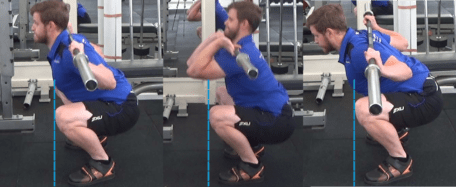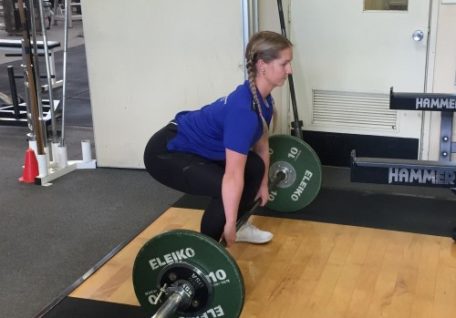This might sound controversial, but when you squat your knees can definitely go past your toes. The technique cue “don’t let your knees move past your toes” has been around for a long time. Its origin is mostly unknown as it isn’t backed up by a lot of science. It was most likely (poorly) used to correct a very specific technique error once and it has snowballed since then into the common technique cue that it is today.
Let’s start by quickly analyzing the squat and talking about the joint actions used. The three main joint actions performed during the concentric phase (also known as the up phase, or the hard part) of the squat are hip extension, knee extension, and ankle plantarflexion. Good squat technique begins with the hips moving first, and the client maintaining their center of gravity over the midfoot throughout the movement. This results in an even weight distribution between the hips and knees, and yes, the knees may move past the toes.
Poor squatting technique begins with the knees driving forward before the hips, which causes the weight to shift onto the balls of the feet, and stops the knees from moving past the toes. While this may not sound like a big problem, by shifting the weight to the balls of the feet there is an increase in shearing force on the knee which can cause knee pain and increases the risk of injury.
The image below shows three different variations on the barbell back squat. A high bar, low bar, and front squat. In all three variations at the bottom on the squat the knees pass the toes, yet all the other KPI’s for a squat are being met without pain or discomfort. The primary KPI being the clients centre of gravity (the barbell) is positioned over the middle of their foot, with a neutral spine at full depth.
When correcting squat technique, it is better to look at what joint moves first and where the weight is distributed, rather than where the knees go. If the hips are moving first, the clients spine remains neutral, and, most importantly, the centre of gravity remains over the middle of the foot, knees can move past the toes in a deep squat.
What joint actions does a squat use?
The three main joint actions are hip extension, knee extension, and ankle plantarflexion
What's a poor squatting technique?
Poor squatting technique begins with the knees driving forward before the hips, which causes the weight to shift onto the balls of the feet, and stops the knees from moving past the toes. By shifting the weight to the balls of the feet there is an increase in shearing force on the knee which can cause knee pain and increases the risk of injury.








